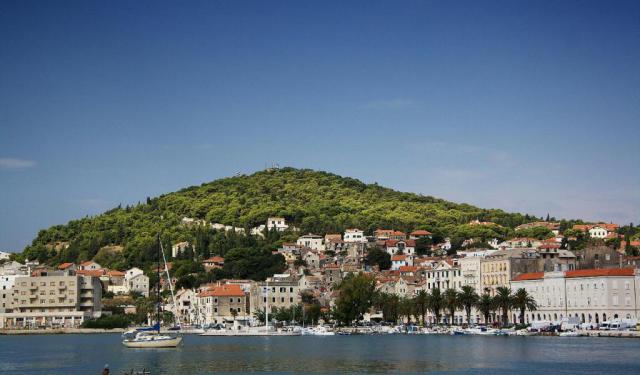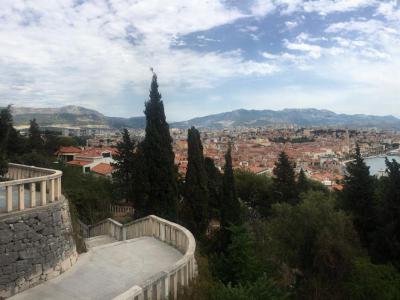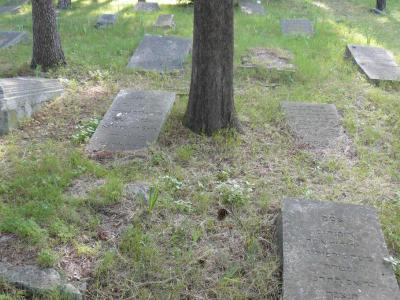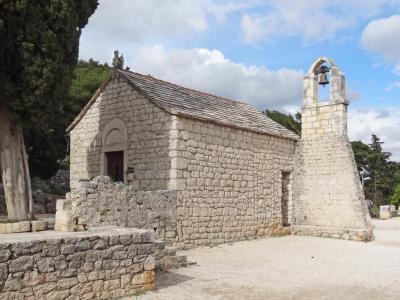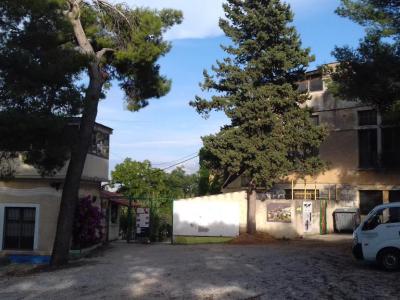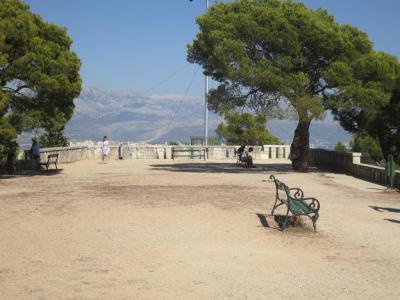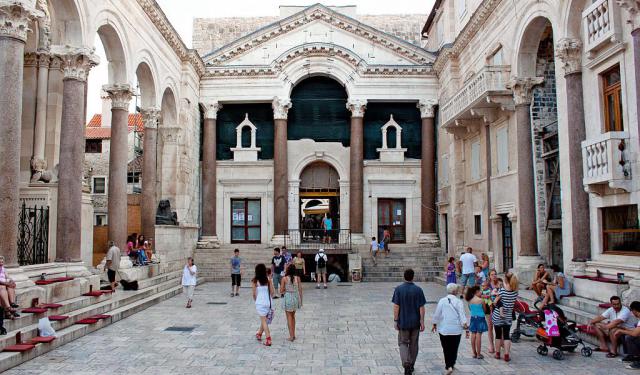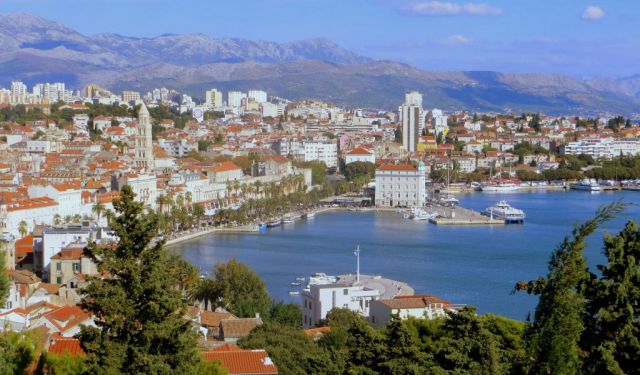Marjan Hill Walking Tour (Self Guided), Split
Marjan Hill is a picturesque natural wonder – a unique landform – located on the Split peninsula in Croatia. The majestic hill (or the low mountain, if you like) is surrounded by the sea and the city, and represents the green oasis ideal for walks, excursions, and rock climbing. Visitors to the area are greeted with a plethora of sights catering to various interests and equally enjoyed by locals and tourists.
The foremost highlight of Marjan Hill is the Marjan Hill Viewpoint, which provides breathtaking panoramic vistas of the Adriatic Sea, the historic city of Split, and the surrounding islands. It's a perfect spot for capturing Instagram-worthy photos or simply taking in the beauty of the Croatian coastline.
For history enthusiasts, the Old Jewish Cemetery on Marjan Hill is a solemn yet intriguing site. Being in place for over 400 years, it bears witness to the rich cultural heritage of Split, offering a glimpse into the city's diverse past.
Saint Nicholas Church, nestled amidst the lush greenery of Marjan Hill, is another notable attraction. This charming church, dating back to the 13th century, boasts beautiful architecture and a peaceful ambiance that invites contemplation and reflection.
Nature lovers will find delight in the Natural History Museum and the Zoological Garden, both of which are located on the hill. These institutions showcase the region's rich biodiversity and provide an educational experience for visitors of all ages.
For the adventurous, a hike up Marjan Hill to Telegrin Peak is a rewarding endeavor. The trek offers an opportunity to connect with nature, as well as a chance to enjoy a serene environment away from the city's hustle and bustle.
Marjan Hill is a multifaceted gem that combines natural beauty, cultural heritage, and recreational activities. When in Split, consider taking this self-guided tour as a chance to explore this fascinating destination and experience the magic of Marjan Hill for yourself.
The foremost highlight of Marjan Hill is the Marjan Hill Viewpoint, which provides breathtaking panoramic vistas of the Adriatic Sea, the historic city of Split, and the surrounding islands. It's a perfect spot for capturing Instagram-worthy photos or simply taking in the beauty of the Croatian coastline.
For history enthusiasts, the Old Jewish Cemetery on Marjan Hill is a solemn yet intriguing site. Being in place for over 400 years, it bears witness to the rich cultural heritage of Split, offering a glimpse into the city's diverse past.
Saint Nicholas Church, nestled amidst the lush greenery of Marjan Hill, is another notable attraction. This charming church, dating back to the 13th century, boasts beautiful architecture and a peaceful ambiance that invites contemplation and reflection.
Nature lovers will find delight in the Natural History Museum and the Zoological Garden, both of which are located on the hill. These institutions showcase the region's rich biodiversity and provide an educational experience for visitors of all ages.
For the adventurous, a hike up Marjan Hill to Telegrin Peak is a rewarding endeavor. The trek offers an opportunity to connect with nature, as well as a chance to enjoy a serene environment away from the city's hustle and bustle.
Marjan Hill is a multifaceted gem that combines natural beauty, cultural heritage, and recreational activities. When in Split, consider taking this self-guided tour as a chance to explore this fascinating destination and experience the magic of Marjan Hill for yourself.
How it works: Download the app "GPSmyCity: Walks in 1K+ Cities" from Apple App Store or Google Play Store to your mobile phone or tablet. The app turns your mobile device into a personal tour guide and its built-in GPS navigation functions guide you from one tour stop to next. The app works offline, so no data plan is needed when traveling abroad.
Marjan Hill Walking Tour Map
Guide Name: Marjan Hill Walking Tour
Guide Location: Croatia » Split (See other walking tours in Split)
Guide Type: Self-guided Walking Tour (Sightseeing)
# of Attractions: 5
Tour Duration: 1 Hour(s)
Travel Distance: 1.4 Km or 0.9 Miles
Author: DanaOffice
Sight(s) Featured in This Guide:
Guide Location: Croatia » Split (See other walking tours in Split)
Guide Type: Self-guided Walking Tour (Sightseeing)
# of Attractions: 5
Tour Duration: 1 Hour(s)
Travel Distance: 1.4 Km or 0.9 Miles
Author: DanaOffice
Sight(s) Featured in This Guide:
- Marjan Hill Viewpoint
- Old Jewish Cemetery
- St. Nicholas Church
- Natural History Museum and the Zoological Garden
- Marjan Hill Telegrin Peak
1) Marjan Hill Viewpoint
Marjan Hill fits the definition, "And now, for something completely different..." it holds a special place in the life of the City. For years city dwellers would see the old Yugoslav flag flying from the top of the hill. Now, Croatia, proudly independent, flies its own flag on top of Marjan Hill. In 1964 Marjan became a park and part of the city.
The park extends from Marmont Street west for nearly two miles. During summer months, amid the chaotic pace of the town it is a popular escape. The hills and woods of the park are the very lungs of the city. It is the preferred place for walking, jogging, climbing, or bike riding.
The highest peak in the park is Telegrin, so named for the telegraph which stood there in Napoleonic times. The park is also the location of the Ivan Mestrovic Gallery, an art gallery open to the public. Meje Split neighborhood, the city's elite seaside beach district is here, surrounded by the sea on three sides.
There are many possible entrances to Marjan Park. The favored one begins at Terrace Vidilica, a bar and restaurant with a great view. This is but a five minute walk from the promenade. If walking be prepared for an early climb.
The park extends from Marmont Street west for nearly two miles. During summer months, amid the chaotic pace of the town it is a popular escape. The hills and woods of the park are the very lungs of the city. It is the preferred place for walking, jogging, climbing, or bike riding.
The highest peak in the park is Telegrin, so named for the telegraph which stood there in Napoleonic times. The park is also the location of the Ivan Mestrovic Gallery, an art gallery open to the public. Meje Split neighborhood, the city's elite seaside beach district is here, surrounded by the sea on three sides.
There are many possible entrances to Marjan Park. The favored one begins at Terrace Vidilica, a bar and restaurant with a great view. This is but a five minute walk from the promenade. If walking be prepared for an early climb.
2) Old Jewish Cemetery
On the eastern edge of the Marjan is the Old Jewish Cemetery founded in 1573. The cemetery has just over 700 graves. The last burial was in 1945. Then the cemetery was closed to further burials and it was declared to be a national monument.
The land for the cemetery was bought by Daniel Rodrigo in 1573. Daniel was a refugee from the Inquisition in Portugal. An skilled negotiator, he secured a trading deal between Split and the Venetian Republic. It involved the transshipment of goods from the east through Split to Venice. It proved to be a benefit to Split and the Jewish community.
The oldest graves have a flat slab on top or a sarcophagus roof. The older stones are engraved with Hebrew inscriptions. The more recent grave markers are similar to non-Jewish Croatian graves.
Today, the 100 or so members of the Jewish community in Split have a designated Jewish section at the Public Cemetery of Lovrinac, where a Holocaust memorial can be found.
The land for the cemetery was bought by Daniel Rodrigo in 1573. Daniel was a refugee from the Inquisition in Portugal. An skilled negotiator, he secured a trading deal between Split and the Venetian Republic. It involved the transshipment of goods from the east through Split to Venice. It proved to be a benefit to Split and the Jewish community.
The oldest graves have a flat slab on top or a sarcophagus roof. The older stones are engraved with Hebrew inscriptions. The more recent grave markers are similar to non-Jewish Croatian graves.
Today, the 100 or so members of the Jewish community in Split have a designated Jewish section at the Public Cemetery of Lovrinac, where a Holocaust memorial can be found.
3) St. Nicholas Church
One characteristic of the Marjan Hills is a harborage of churches. They are mini-churches, almost like the tiny churches in the guard towers of Diocletian's Palace. They nestle in the forest, beside the trails or carved into the rock of the hillsides. They date from medieval times, offering spiritual retreat to the citizens of Split.
Saint Nicholas qualifies as one of these havens from the world. It is small. It is an early rustic chapel from the 13th century. The church is devoted to Saint Nicholas, patron saint of fishermen. There are a respectable number of fishermen in Split.
The church was built by one Rako and his wife in 1219. It was donated to the Abbey of Saint Stephen on Sustipan. Later it was cared for by Benedictine monks and even later by hermits. Today it is in the care of the Marjan society.
Saint Nicholas on the Hill is perched on the southeast slopes of Marjan, watching over the sea and the ships and the sailors who go to sea.
Saint Nicholas qualifies as one of these havens from the world. It is small. It is an early rustic chapel from the 13th century. The church is devoted to Saint Nicholas, patron saint of fishermen. There are a respectable number of fishermen in Split.
The church was built by one Rako and his wife in 1219. It was donated to the Abbey of Saint Stephen on Sustipan. Later it was cared for by Benedictine monks and even later by hermits. Today it is in the care of the Marjan society.
Saint Nicholas on the Hill is perched on the southeast slopes of Marjan, watching over the sea and the ships and the sailors who go to sea.
4) Natural History Museum and the Zoological Garden
The Marjan Zoo, located in Split, Croatia, was once a combined institution comprising the Natural History Museum and the Zoological Garden. However, in 2014, due to mounting protests by ecological organizations, the zoo was closed, and the facility has since been operating solely as a museum.
In June 2015, following the closure of the museum and zoo in 2014, an artistic collective initiated by Hrvoje Cokarich, an artist from Split, took it upon themselves to assist the remaining animals. Since 2016, these artists have continuously devised innovative solutions to prevent the extinction of these creatures. Children have the opportunity to delight in the presence of various domestic animals, including donkeys, rabbits, turtles, chickens, turkeys, horses, cows, sheep, and goats. The zoo delivers an enriching and hands-on experience, promoting a deeper comprehension of wildlife preservation and biodiversity. Through opportunities to observe, learn about, and actively participate in feeding sessions, the zoo presents an unforgettable engagement with the animal kingdom.
The Natural History Museum's extensive collections have continued to flourish, encompassing various fields of natural history, including mineralogy, geology, paleontology, botany, and zoology. This museum houses hundreds of thousands of exhibits.
Visitors to the Natural History Museum can explore the numerous facets of the natural world through its collections. One of the highlights is a remarkable collection of shells, totaling nearly 7,000 specimens, which is sure to captivate those with an interest in marine biology.
The museum's second permanent exhibition is dedicated to the forest fauna of the Croatian Adriatic coast. This exhibit is designed in the form of a series of dioramas, featuring taxidermied animals, including mammals, reptiles, amphibians, and birds from the museum's collection. This immersive display provides a comprehensive view of the wildlife found along the Adriatic coast of Croatia.
In June 2015, following the closure of the museum and zoo in 2014, an artistic collective initiated by Hrvoje Cokarich, an artist from Split, took it upon themselves to assist the remaining animals. Since 2016, these artists have continuously devised innovative solutions to prevent the extinction of these creatures. Children have the opportunity to delight in the presence of various domestic animals, including donkeys, rabbits, turtles, chickens, turkeys, horses, cows, sheep, and goats. The zoo delivers an enriching and hands-on experience, promoting a deeper comprehension of wildlife preservation and biodiversity. Through opportunities to observe, learn about, and actively participate in feeding sessions, the zoo presents an unforgettable engagement with the animal kingdom.
The Natural History Museum's extensive collections have continued to flourish, encompassing various fields of natural history, including mineralogy, geology, paleontology, botany, and zoology. This museum houses hundreds of thousands of exhibits.
Visitors to the Natural History Museum can explore the numerous facets of the natural world through its collections. One of the highlights is a remarkable collection of shells, totaling nearly 7,000 specimens, which is sure to captivate those with an interest in marine biology.
The museum's second permanent exhibition is dedicated to the forest fauna of the Croatian Adriatic coast. This exhibit is designed in the form of a series of dioramas, featuring taxidermied animals, including mammals, reptiles, amphibians, and birds from the museum's collection. This immersive display provides a comprehensive view of the wildlife found along the Adriatic coast of Croatia.
5) Marjan Hill Telegrin Peak
One sees signs for "Marjan Hill" and a few steps later there is a totally different world. Marjan Hill Park extends out from Split on a rugged peninsula jutting into the Adriatic. The park is densely forested, mostly with pines. The forest is a sign of recovery. Over the years the hills of what is now Marjan were stripped bare.
The peninsula reforested but it was too rugged to build on except for the ancient Jewish cemetery, and many very small churches or chapels hidden under the trees or carved into the hillsides. The highest point is a hill called Telegrin. When Napoleon's armies controlled Dalmatia. There was a telegraph signal tower atop the hill.
The hill was the perfect place for a visual telegraph. The hill can be seen for miles around, especially from the sea. The telegraph is long gone but the Croatian flag remains. Napoleon didn't stay long. He was a busy man.
Marjan Hill is 178 meters (578.8 feet) high. The peak can be reached by a staircase of 314 steps. Getting around the park can involve some serious climbing, but not to worry. There are dozens of benches conveniently placed. Be sure to bring good shoes for hiking, snacks and plenty of water.
The peninsula reforested but it was too rugged to build on except for the ancient Jewish cemetery, and many very small churches or chapels hidden under the trees or carved into the hillsides. The highest point is a hill called Telegrin. When Napoleon's armies controlled Dalmatia. There was a telegraph signal tower atop the hill.
The hill was the perfect place for a visual telegraph. The hill can be seen for miles around, especially from the sea. The telegraph is long gone but the Croatian flag remains. Napoleon didn't stay long. He was a busy man.
Marjan Hill is 178 meters (578.8 feet) high. The peak can be reached by a staircase of 314 steps. Getting around the park can involve some serious climbing, but not to worry. There are dozens of benches conveniently placed. Be sure to bring good shoes for hiking, snacks and plenty of water.
Walking Tours in Split, Croatia
Create Your Own Walk in Split
Creating your own self-guided walk in Split is easy and fun. Choose the city attractions that you want to see and a walk route map will be created just for you. You can even set your hotel as the start point of the walk.
Diocletian Palace Tour
One of the best preserved monuments of the Roman architecture in the world, Diocletian's Palace was built for the Emperor Diocletian, at the turn of the 4th century AD, as his retirement home. Massive and resembling a fortress rather, it represents a combination of a luxury villa and a military garrison, and is divided into four parts by two main streets. Integral of the historic core of... view more
Tour Duration: 1 Hour(s)
Travel Distance: 0.6 Km or 0.4 Miles
Tour Duration: 1 Hour(s)
Travel Distance: 0.6 Km or 0.4 Miles
Split Introduction Walking Tour
Split is the largest city in Dalmatia. It is a regional transport center, a tourist magnet, and the ancient dacha of the Roman emperor Diocletian. Like most other cities of the Mediterranean, it started out as a Greek colony. The original name was Aspalatos.
Supposedly, the city owes its name to the word for "spiny broom." Which spiny broom is not clear, but history has many such... view more
Tour Duration: 1 Hour(s)
Travel Distance: 1.2 Km or 0.7 Miles
Supposedly, the city owes its name to the word for "spiny broom." Which spiny broom is not clear, but history has many such... view more
Tour Duration: 1 Hour(s)
Travel Distance: 1.2 Km or 0.7 Miles
The Most Popular Cities
/ view all
